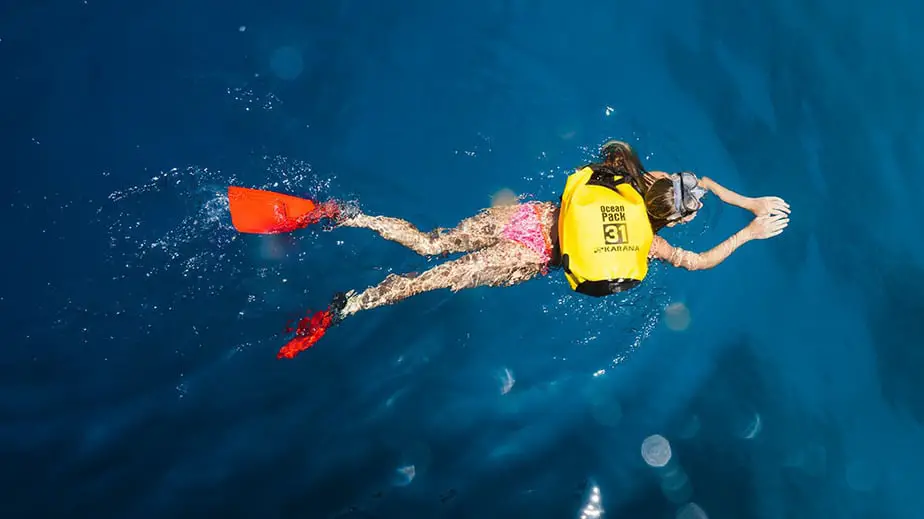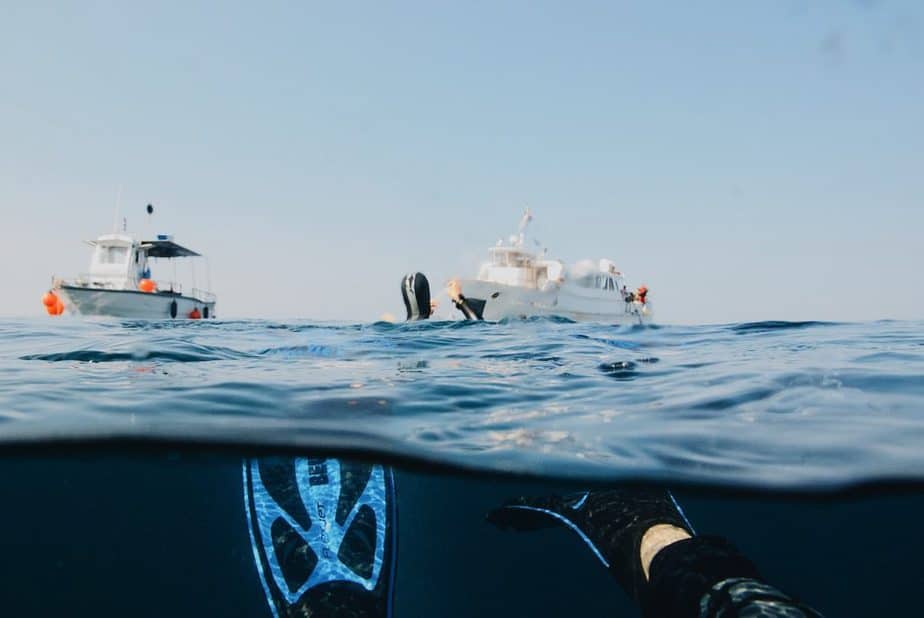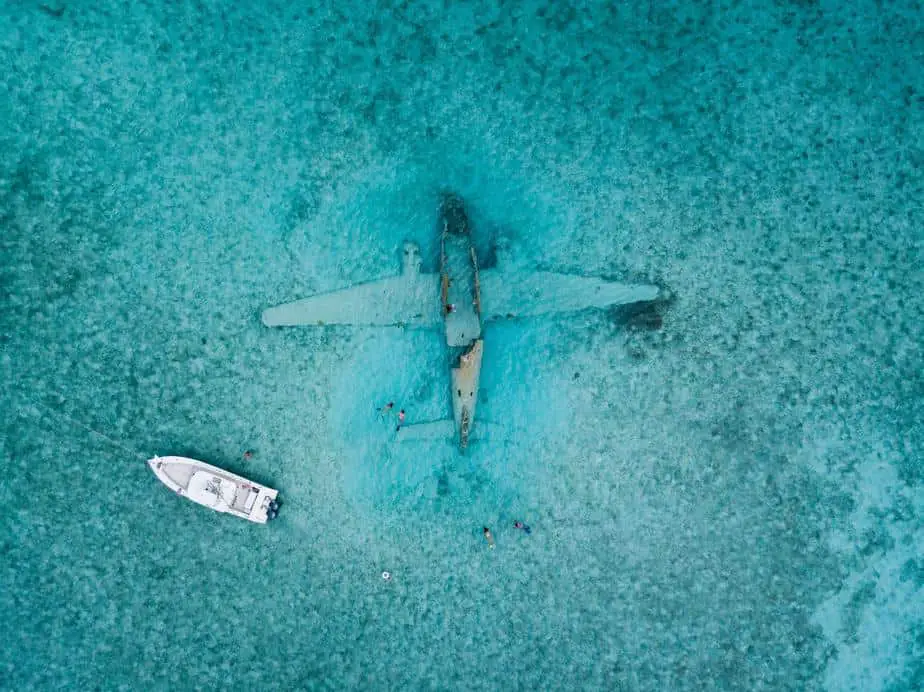Snorkeling from a boat is a fantastic experience that beats snorkeling from the shore. When you join a dive charter or boat tour, you will get to experience prime diving and snorkeling spots around the area. You will experience sights that are only accessible via a boat. For instance, charters let you see healthier reefs and submerged wrecks which you probably won’t find around resort areas.
When you snorkel from a boat, you get access to more colorful coral and greater fish populations, even larger sea creatures such as turtles and sharks. Furthermore, as part of the snorkel cruise, you get the assistance of staff to teach you how to use the equipment, stay safe, and keep an eye out for your well-being. Furthermore, you can expect beverages and lunch to be provided as part of the tour. Sounds pretty good to me.
How to Snorkel from a Boat
When you’re on the boat, the staff will take good care of you. But before that, there are some useful bits of information that you should know to make the experience even better.
Don’t Be Late
Don’t be that person that everyone is waiting on. Nothing fouls the mood more quickly than finding out that your precious snorkeling time is being used up waiting on tardy passengers who don’t respect others’ time. Typically, transfer is arranged from the customers’ resort directly to the pier, so you just have to be ready to leave.
If you have a different arrangement, such as meeting at the pier or marina, then arrive early. You’ll find that things don’t always go according to plan, so leaving early will probably end up in you arriving just in the nick of time. And if everybody on the tour aims to arrive early, then the chances of leaving on time is improved significantly.
Again, don’t be that person that everyone is waiting on! Your fellow passengers are the ones that are going to be rescuing you in the case of an emergency, so don’t rub them the wrong way!
Bring a Dry Bag
You traveled far to get to the snorkeling location, so you probably brought a camera or other electronics with you to help you capture the memories forever. Well, chances are your bags will get splashed by water, and unless you have a water-resistant dry bag you can easily damage your equipment.
You should also bring some plastic bags to put your wet swimwear and towels to keep your bag from getting damp. Furthermore, dry bags have simple designs and often look similar, so make sure to label or tag yours in some way to differentiate it from the rest.

Bring Only the Essentials
Space is tight on most boats, especially speedboats. So people with huge bags, such as backpackers should leave most of their stuff at the resort. Here is what you should bring with you on a boat trip:
- Booking Voucher: So that you can get entry to the boat and you confirmed that you are on the right boat. There are often multiple tours leaving at the same time, so you want to ensure you’re on the right one.
- Sun Protection: Do not underestimate the amount of damage the sun can do to your skin. Even on cloudy days, the UV rays can still penetrate the clouds. Even underneath the boat’s canopy, you may still get affected by the rays that reflect up from the water. You need to bring a biodegradable water-resistant sunscreen or be wearing a rash vest with a 50+ UPF rating. And no, a t-shirt is not adequate sun protection for snorkeling unless it has a UPF rating.
- Waterproof Camera: The underwater sights are amazing, so why not capture them forever. You can also show your friends and family. In comparison, a regular camera can only be used on the boat and will get damaged if splashed by water.
- Phone: Most boat excursions are still within range of a cell tower. On longer liveaboard trips to faraway reefs, you may lose cell signal.
- Dry change of clothes.
- A Towel. Most tours do not provide towels, so bring your own.
- Swimwear. We recommend a rash vest.
- Beach Appropriate Footwear. Sandals, flip flops, crocs, water shoes, etc. Basically anything that you don’t mind getting soaked, is water resistant, and drains quickly.
- Cash. You never know what you might have to pay a fee at a national park, or if you want to have snacks, a beer, souvenirs, or paying for a tip. Always keep some pocket change around. Don’t expect most places to accept credit cards.
- Medication for Seasickness. If you find yourself getting queasy or nauseous due to the rocking of the boat, unfortunately it’s already too late. Seasickness medication should be taken early so that you can avoid the symptoms. We recommend taking a pill with breakfast.
Space is limited on a ship, so only bring the above and no more. Most boats have a dedicated storage area for your belongings. On smaller speedboats, you can store the bags under the seat. Make sure you put it in a place where it won’t get stepped on or splashed by water.

Follow the Rules
Listen to what the staff have to say. They’ll explain what you should or shouldn’t do, as well as how they can assist you. For instance, you shouldn’t feed the fish. They’ll also provide some general information on the location you are heading to, safety procedures like how to enter and exit the boat. It’s generally very laid back and informal, but that doesn’t mean you can ignore it. The staff will also teach you how to do some basic signals such as “distress”, “okay”, and “recall”.
Exiting the Boat into Water
How you exit the boat depends on the snorkeling location and type of boat. For all boats, you will already have your snorkel, mask, and fins on before you exit.
Some boats have a rear platform that you step off into the water in what is known as the “giant stride” entry. You need to have your hands on your snorkel and mask when you do this, since the sudden drop can knock them out of place. If you are holding a camera, then using your one free hand hold it as high above your head as possible. This lowers the impact and reduces the chances of waterproof cases opening.
In other boats you may be expected to do a seated entry from the side. From a RIB you can pretend you’re a NAVY seal and do a backwards roll. Entering from a speedboat can be any combination of these. Again, listen to the staff as they will teach you how to safely enter the water.
Entering the Boat from the Water
When you re-enter the boat that has ladders, there are numerous steps that you have to take to ensure it is quick, smooth, and safe.
- Remove your fins. You need to do it one at a time. There will be boat staff available to assist you, and you should pass the fins to them. To remove the right fin, hold the ladder with your left hand and use your right hand to take the fin off and pass it to the staff. Then hold the ladder with your right hand and remove the left fin with your left hand.
- Keep your snorkel and mask on you for now. If you want, you can take off the mask and let it hang around your neck. Don’t keep the mask on your forehead because it can easily slip off and get lost in the ocean.
- Wait Your Turn. If someone else is climbing the ladder, leave some space. This is just in case the climber slips and falls back into the water, you want to keep your distance.
- Climb the Ladder. Watch your fingers when climbing up the ladder. The ladders are often moving around on a hinge and it is easy to pinch your fingers as the boat is moving around. If the ladder is bouncing a lot, wait for it to bounce into your hands.
- Collect Your Fins. Once aboard, retrieve your fins so that you have them in case you need to use them again.
In poor water conditions, the boat staff may deploy a floating rope line for you to grasp as you wait your turn. You can begin removing your fins at a distance so that once it’s your turn to climb the ladder you can just go up. Once the fins are removed, clasp both of them together with one hand, and use the free hand to grab the ladder and pull yourself up. The rope helps speed up the process so everyone can quickly exit.
On smaller boats without a ladder, keep your fins on and kick hard with them to help you get over the side and into the boat.

Boat Etiquette
There are some unwritten, unspoken boat rules that you should follow to make sure everybody is happy. First, lunch is typically provided on the trip and food may be limited. Don’t go back for seconds until everybody has received their portion.
Also, if you have garbage such as plastic wrappers or empty bottles, do NOT throw them overboard. There is already so much plastic waste polluting our oceans, so don’t be part of the problem. Smoke only in smoking designated areas (if any) and don’t throw cigarette butts into the ocean.
Water Etiquette
- Always keep an eye out so that you don’t hit other people or the boat.
- Stay in close proximity to the boat and don’t swim off on your own.
- Pay attention to currents that may be pulling you farther from the boat.
- Look out for other boats; this shouldn’t be an issue if you stay within the designated area.
- Return to the boat immediately when called back.
- Do not feed any animals.
- Do not touch the corals or fish. Coral is easily damaged, and fish may attack you if they feel threatened.
Should You Snorkel from a Boat?
Personally, we recommend first time snorkelers take part in a snorkel cruise. It can be stressful and nerve wracking doing something on your own for the first time, so why not make the experience a good one with some expert help.
As part of a boat tour, you will get access to snorkeling locations you normally wouldn’t, and you get to see extremely beautiful sights that are hard to find on your own. The boat crew are highly trained and can answer any beginner questions you have in regards to snorkeling.
One extremely important snorkeling advice is to never snorkel alone. Well, with a tour guide, you will always be in the company of other people, many first-time snorkelers as well. You’ll also likely be provided a flotation device to help you stay afloat in the water. As long as you follow the crew’s instructions and follow the basic etiquette, the boat tour should go very smoothly.
But more importantly, if you wanted to get a taste of snorkeling, then you probably got to experience the joy that snorkeling from a boat can provide.


